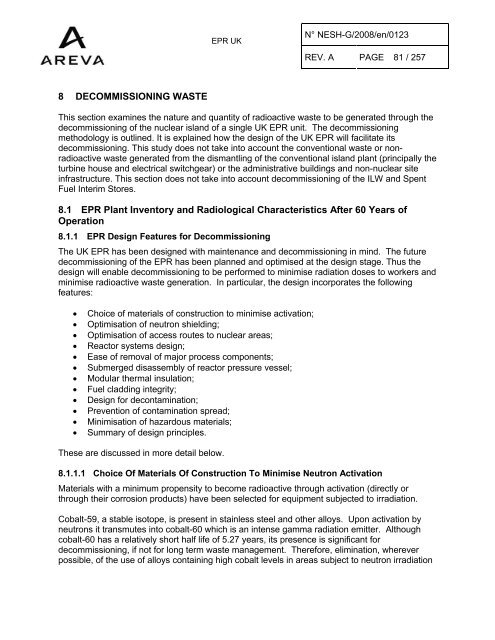Solid Radioactive Waste Strategy Report.pdf - UK EPR
Solid Radioactive Waste Strategy Report.pdf - UK EPR
Solid Radioactive Waste Strategy Report.pdf - UK EPR
Create successful ePaper yourself
Turn your PDF publications into a flip-book with our unique Google optimized e-Paper software.
<strong>EPR</strong> <strong>UK</strong><br />
N° NESH-G/2008/en/0123<br />
REV. A PAGE 81 / 257<br />
8 DECOMMISSIONING WASTE<br />
This section examines the nature and quantity of radioactive waste to be generated through the<br />
decommissioning of the nuclear island of a single <strong>UK</strong> <strong>EPR</strong> unit. The decommissioning<br />
methodology is outlined. It is explained how the design of the <strong>UK</strong> <strong>EPR</strong> will facilitate its<br />
decommissioning. This study does not take into account the conventional waste or nonradioactive<br />
waste generated from the dismantling of the conventional island plant (principally the<br />
turbine house and electrical switchgear) or the administrative buildings and non-nuclear site<br />
infrastructure. This section does not take into account decommissioning of the ILW and Spent<br />
Fuel Interim Stores.<br />
8.1 <strong>EPR</strong> Plant Inventory and Radiological Characteristics After 60 Years of<br />
Operation<br />
8.1.1 <strong>EPR</strong> Design Features for Decommissioning<br />
The <strong>UK</strong> <strong>EPR</strong> has been designed with maintenance and decommissioning in mind. The future<br />
decommissioning of the <strong>EPR</strong> has been planned and optimised at the design stage. Thus the<br />
design will enable decommissioning to be performed to minimise radiation doses to workers and<br />
minimise radioactive waste generation. In particular, the design incorporates the following<br />
features:<br />
· Choice of materials of construction to minimise activation;<br />
· Optimisation of neutron shielding;<br />
· Optimisation of access routes to nuclear areas;<br />
· Reactor systems design;<br />
· Ease of removal of major process components;<br />
· Submerged disassembly of reactor pressure vessel;<br />
· Modular thermal insulation;<br />
· Fuel cladding integrity;<br />
· Design for decontamination;<br />
· Prevention of contamination spread;<br />
· Minimisation of hazardous materials;<br />
· Summary of design principles.<br />
These are discussed in more detail below.<br />
8.1.1.1 Choice Of Materials Of Construction To Minimise Neutron Activation<br />
Materials with a minimum propensity to become radioactive through activation (directly or<br />
through their corrosion products) have been selected for equipment subjected to irradiation.<br />
Cobalt-59, a stable isotope, is present in stainless steel and other alloys. Upon activation by<br />
neutrons it transmutes into cobalt-60 which is an intense gamma radiation emitter. Although<br />
cobalt-60 has a relatively short half life of 5.27 years, its presence is significant for<br />
decommissioning, if not for long term waste management. Therefore, elimination, wherever<br />
possible, of the use of alloys containing high cobalt levels in areas subject to neutron irradiation

















